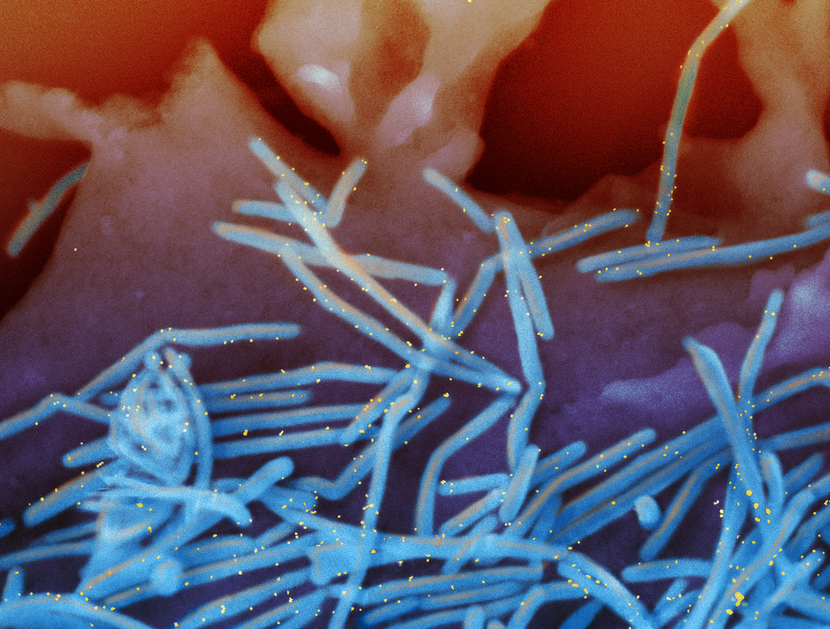The virus of the month: RSV
With about 34 million infections per year, 10% of which require hospitalization, respiratory syncytial virus (RSV) is the most common cause of annual winter lower respiratory tract infections. While for young healthy adults RSV causes mild or even asymptomatic infections, it remains a major cause of complications and deaths in infants, elderly people, and immune-compromised individuals. Also, an association between early infection and the development of asthma and respiratory problems in children is now established.
At a molecular level, we know quite a lot about RSV, but all this information has been hard to translate into effective therapies.
The virology in a nutshell
RSV is a pneumovirus consisting in a 80-350 nm enveloped virion containing a negative, single-stranded RNA genome, together with a number of viral proteins important for the early stages of viral entry and replication. Two main groups exist, A and B, in turn divided into genotypes. The surface glycoprotein G is the most divergent one, with only 53% amino acid identity between the two groups. The non-proofreading activity of the viral polymerase, typical of RNA viruses, highly increases the genetic variability even within groups and genotypes, meaning that previous infections are not necessarily protective. Most neutralizing antibodies are directed against the surface proteins G and F, with the mature form of F exposing more immunogenic epitopes, and therefore eliciting more protective and cross-reactive antibodies. Both proteins contribute to RSV attachment to the cell surface, but it is F the main responsible for receptor binding and fusion. Fusion occurs primarily at the plasma membrane, although internalization upon activation of cellular signaling has also been described. Upon genome release RSV protein L, present inside the virion, transcribes and replicates its genome in the cytoplasm. Assembly of new virions occurs back at the plasma membrane, driven by the matrix protein M.
Vaccines and antivirals: an ongoing challenge
The development of vaccines against RSV didn’t set off to a good start, as the first attempt with formalin inactivation destroyed neutralizing epitopes and failed to raise effective immunity, effectively exacerbating the severity of the disease itself. This led to a major shift to subunit and inactivated vaccines, although to date none of these formulations has made it to the market. This is mostly due to the difficulties of striking the correct balance between protection and pathogenesis. It is known that an excessive immune response activation contributes to disease as much as (if not more than) virus replication itself, and it is likely that a deeper understanding of correlatives of protection and of the balance between protective and pathogenic immunity in different groups of patients may be required to assure efficacy and safety.
Monoclonal antibodies and intravenous immunoglobulins are currently the main strategies for prophylaxis of RSV infection. Palivizumab is a humanized monoclonal antibody directed against the F proteins used in premature infants or children born with pulmonary disorders and it has replaced many of the previous formulations.
Differently from many other viruses, RSV has a larger therapeutic window for antiviral treatment. Peak viral load is reached up to 8 days post-infection, suggesting that drugs are likely to be effective even when administered relatively late compared to other respiratory diseases like flu. That said, the race to develop effective small molecules against RSV is still on, with a number of candidates in clinical trail, but no specific therapy currently available. Ribavirin is currently used as generic inhibitor of viral RNA replication, but its contraindications and teratogenic effects in laboratory models call for a better alternative. Inhibitors of viral entry and fusion like GS-5806 appear to be a particularly promising approach.
While a fair amount of information is available on the molecular virology of RSV, the development of prophylactic and therapeutic strategies remains elusive, in spite of a number of interesting candidates in clinic trial.
At VRS we have recently started working with RSV to support scientists fill the therapeutic gap for what is one of the main respiratory diseases in the western world. If you want us to help advance your research on RSV, get in touch to find out more.




